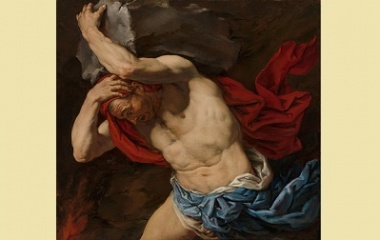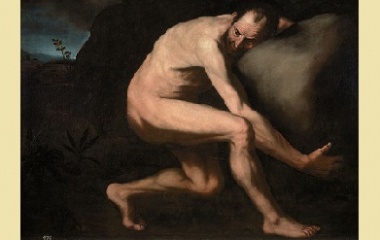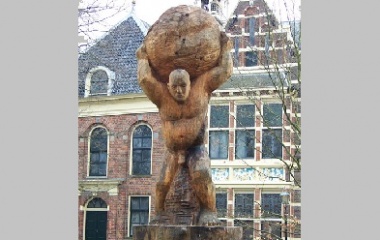- Pronunciation: SIS-ee-phus
- Origin: Greek
- Role: Mortal
- Symbol: Boulder
- Parents: Aeolus and Enarete
- Wife: Merope
- Children: Glaucus, Ornytion, Almus, and Thersander
Who Is Sisyphus?
In Greek mythology, Sisyphus was the king of Ephyra. He founded the city and proclaimed himself to be king. His myth serves as a strong moral lesson that’s still relevant today.
Purpose
The myth of Sisyphus is said to symbolize our own struggles. We have dreams and aspirations, only to find ourselves completing mundane and essentially pointless tasks. This is why Sisyphus is often portrayed as a hero in his own right, and is often used as an example by modern day philosophers.
Legends and Stories
The myth of Sisyphus is familiar to many and often mimicked in modern day tales. But here is the original version that’s so important to Greek mythology.
The Myth of Sisyphus
Sisyphus’ true nature became evident to those around him right from the start. His brother, Salmoneus, stole the throne from Sisyphus. A sorceress named Media helped Sisyphus earn the throne of Ephyra, which he populated by growing residents out of mushrooms. He was a good leader for his people but his decisions were often clouded with poor judgement and selfishness.
One day, Sisyphus found out that a thief named Autolycus was allowing his cattle to get a little too close to the herds belonging to the kingdom. This concerned Sisyphus because he was skilled in his thievery, being able to change the shape and color of anything he stole. It was assumed that he was stealing cattle, as the kingdom’s herd was shrinking while Autolycus’ grew, but no one could prove anything.
Sisyphus wanted to catch the thief in the act so he marked the inside of the animals’ hooves. This allowed them to prove that Autolycus was indeed stealing the cattle. But getting the cattle back and proving the thief’s guilt wasn’t enough for the king. He seduced Autolycus’ daughter Anticleia and possibly fathered Odysseus with her.
Sisyphus relied on this type of revenge another time. He consulted with an oracle to see how he could seek revenge on his brother for stealing the throne from him. He was told that if he fathered children with his brother’s daughter, they would eventually destroy their grandfather.
He forced a relationship with his niece, Tyro. But before the prophecy could come true, Tyro killed both of her children to protect her father.
But Sisyphus didn’t just save his wrath for mortals. He also treated the gods with disrespect. He first offended Zeus. Asopus, a river god, was trying to find his daughter Aegina. Sisyphus made a deal with Asopus, telling him that he would inform him of his daughter’s fate if he promised the king an eternal spring for his kingdom.
Asopus did as he was asked and Sisyphus told him that Zeus had kidnapped his daughter. Asopus attacked Zeus but was no match for the god’s thunderbolts. While it was true that Zeus had abducted the girl, he was furious with Sisyphus for his betrayal. Zeus sent Thanatos, or Death, after the king but he managed to escape by playing a trick.
Death approached the king with handcuffs and Sisyphus outsmarted him by asking him to show them how he worked. Death ended up locked in his own handcuffs and was kept prisoner at Sisyphus’ home. Because Death was unable to fulfill his duties, no one could die. Even if they were severely injured, they wouldn’t die. The Earth began to fill with bloody, mortally wounded, and deathly-ill bodies. Eventually, Ares set Death free and then gave him Sisyphus.
But again, Sisyphus managed to escape. While he did die, he told his wife to not bury him before the incident occurred. When he arrived in the underworld, he spoke to Queen Persephone. He explained that he had not been given the proper burial and therefore had no right to be there. Because he was unburied, he should have been abandoned. He also told Persephone that his wife’s actions could serve as a bad example for future widows and that he needed to rectify the situation.
Persephone agreed to let him return to Earth for just three days, enough time to arrange his funeral and discuss the wrongdoings with his wife, even though they were planned. But instead of returning to the underworld, Sisyphus lived out the rest of his life until natural causes once again sent him back to see Hades.
As punishment for his poor treatment to both mortals and gods, Sisyphus was condemned to a terrible fate. He had to roll a giant boulder from the base of a hill all the way to the top. But each time he made it to the top of the hill, the boulder would roll back down to the bottom and he would be forced to start again. This was eternal punishment and serves as a reminder that the actions we take during our lives have a direct effect on what we can expect during the afterlife.
Family
Sisyphus was married to Merope, a nymph, and together they had four children, named Glaucus, Ornytion, Almus, and Thersander. His father was Aeolus and his mother was Enarete. He had one brother named Salmoneus and his grandson was Bellerophon.
Appearance
In artistic representations of Sisyphus, he is portrayed as a strong middle-aged man. While his strength is obvious, he also appears ragged and worn down. His clothing only covers his waist and just below and he is usually shown pushing a large boulder up a hill to coincide with his myth.
Symbology
The main symbol associated with Sisyphus is the boulder he is forced to push in the afterlife. Other symbols associated with him are not material in nature but rather characteristics. For example, thievery and deceit are both symbolic traits linked to Sisyphus.










